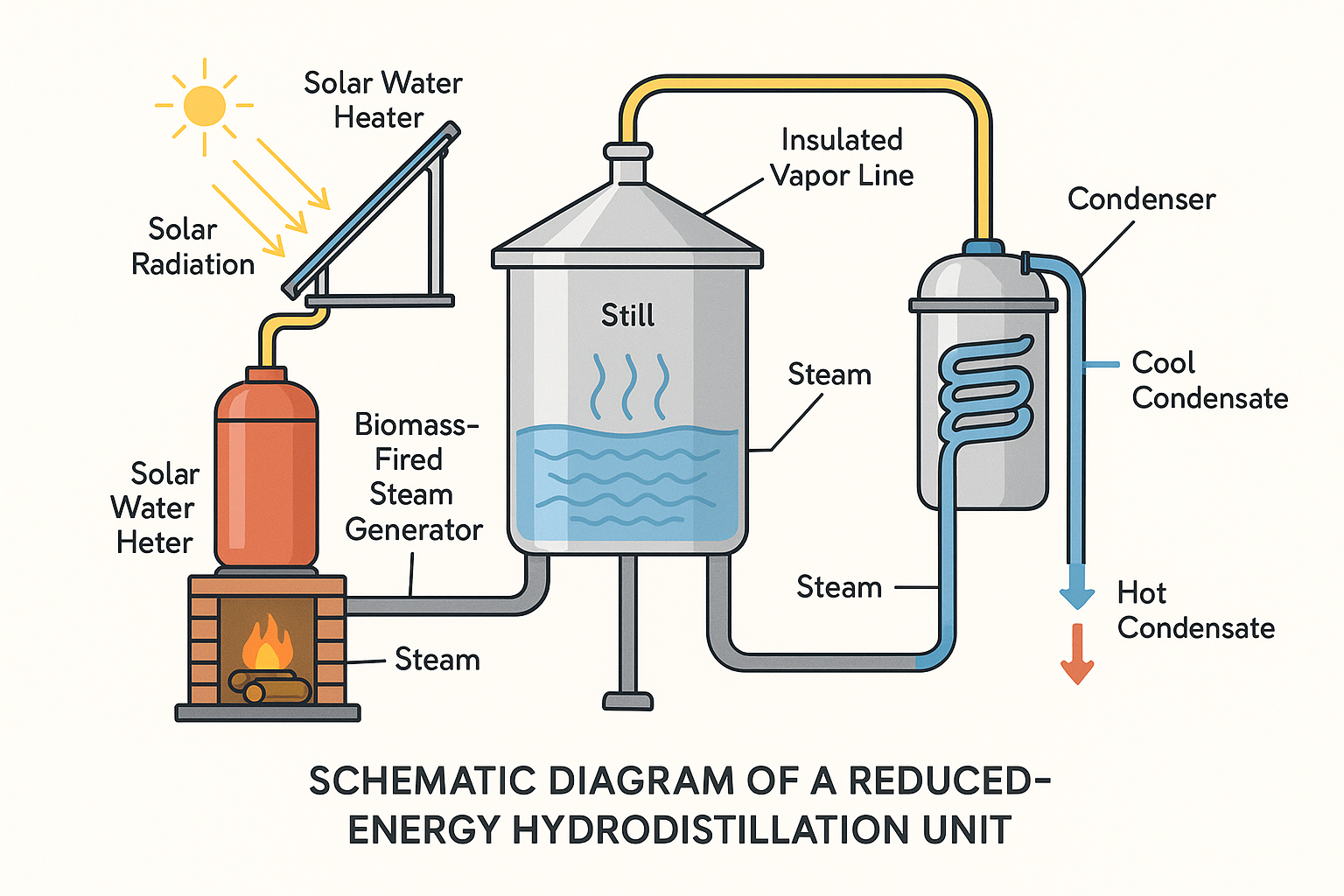Extraction System | Supercritical CO₂ | Hydrodistillation | Microwave | Ultrasound | Enzyme-Assisted
Reducing energy consumption during hydrodistillation—commonly used to extract essential oils from aromatic plants like Aquilaria, Cinnamomum, Cananga, etc.—is crucial for sustainable processing, especially in rural or off-grid settings.
Strategies, technologies, and process innovations to optimize hydrodistillation with reduced energy usage, without compromising oil yield or quality:
Energy-Efficient Hydrodistillation Strategies
1. Insulated Distillation Units
- Insulate the boiling chamber and vapor line with materials like ceramic fiber, rock wool, or reflective foil
- Minimizes heat loss, improving thermal efficiency by 15–30%
- Especially effective in open-fire or LPG-fired setups
2. Condensate Water Reuse System
- Recycle hot condensate water from the condenser into the boiling chamber
- Saves up to 30% fuel energy, as reused water is already near boiling point
- Helps maintain distillation pressure & temperature
3. Low-Pressure Steam Hydrodistillation
- Modify system to operate under low-pressure steam (~1–1.5 atm)
- Shortens extraction time and reduces energy per kg of biomass
- Requires sealed units and pressure control valves
4. Solar-Assisted Hydrodistillation
- Integrate solar water heaters or flat-plate collectors to preheat water or steam
- Reduces LPG/firewood use by 40–60% during daylight operations
- Feasible for community distillation units in tropical zones
5. Biomass-Fired Steam Generators
- Use agro-waste (e.g., agarwood prunings, rice husk, coconut shells) as fuel
- Retrofit your boiler with a gasifier or efficient rocket stove design
- Reduces firewood demand and carbon footprint
6. Batch Time Optimization
- Pre-soak or pre-crush plant material to reduce distillation time by 15–25%
- Apply enzymatic softening (pectinase, cellulase) before distillation to weaken cell walls
7. Coil-in-Coil or Plate Condensers
- Replace old copper pipe condensers with multi-surface stainless coil or plate-type
- Achieve faster and more efficient vapor condensation with less cooling water and time
8. Smart Process Monitoring
- Use temperature sensors and automated shut-off valves to prevent overheating or unnecessary run time
- Real-time monitoring can cut fuel waste by 10–20%
9. Hydrodiffusion + Intermittent Steam Flow (Pulse Mode)
- Pulse-mode steam application with intermittent shutoff cycles allows better oil yield with less continuous energy input
- Especially useful for resinous woods and roots
10. Compact Modular Stills
- Design modular stills (20–50L) for small-batch, targeted distillation
- Heats faster and consumes less fuel per run
- Ideal for community co-op or mobile distillation units

Expected Energy Savings Table
| Strategy | Energy Savings | Notes |
|---|---|---|
| Insulation | 15–30% | Easy retrofit |
| Condensate reuse | 20–30% | Improves cycle time |
| Solar preheat | 40–60% | Daylight only |
| Biomass burner | 50–70% vs. LPG | Eco-friendly |
| Enzyme pre-treatment | 15–25% | Boosts oil recovery, shortens run time |
Recommended Hybrid Setup for Sustainable Operations
For a rural agarwood distillery:
- Solar preheater + biomass-fired boiler (rice husk/coconut shell)
- Fully insulated stainless still (50–100L)
- Enzyme pre-treatment chamber (BioFusion™-ready)
- Condensate reuse & digital temp sensor + manual timer
Up to 60–70% total energy savings

